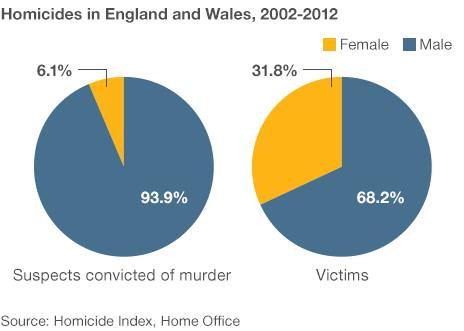Dennehy murder case: Why do women kill?
- Published

Top, left to right: Mary Ann Cotton, Rose West, Myra Hindley. Bottom, left to right: Juana Barraza, Beverly Allitt, Aileen Wuornos
Two men have been found guilty of aiding triple murderer Joanne Dennehy. What makes her case so rare, and why do women kill?
British history is spattered with grim tales of multiple murderers and serial killers.
From Jack the Ripper, who terrorised Victorian London, to Dr Harold Shipman, who murdered hundreds of his patients without, it seems, any motive - the cases have fascinated as much as they have disturbed.
But they often have one thing in common - the perpetrators are all men.
While serial killings by men or women are rare, the case of 31-year-old Joanne Dennehy, who has admitted stabbing to death three men, appears to be highly unusual.
Smother, strangle or poison
Criminologist Prof David Wilson describes murder as a "man's business".
He says it is usually the preserve of young working class men, who kill other young men of a similar background.

The court heard Dennehy was driven by a thirst "for blood" as she sought further victims
Of suspects convicted of murder in England and Wales over a 10-year period up to 2012 more than 90% were men, Home Office figures show.
And in the rare instances that women do kill, they tend to kill different groups of people to men and use different methods, says Wilson.
"By and large women kill children in their own family - they are intra-familial [killers] - and they tend to smother, strangle and poison, and only occasionally they will stab. That is the pattern generally."
Consultant forensic psychologist Kerry Daynes says women are more "practical and clean" in their killing. They use enough violence to get the job done but nothing more.
"It may be that women are more driven by the end product - of someone being dead and the aftermath of that - [rather] than the actual act of killing itself."

Wilson says men are more likely to use violent methods, like shooting and stabbing, possibly because they have more access to weapons.
Men's victims tend to be strangers because they are more likely to find themselves in aggressive situations, such as trying to fight or resolve conflicts in nightclubs or in the street, says the professor.
"That kind of confrontational murder is not one that one sees when women are in those social spaces."
But what might make a woman kill in a multiple or serial way?
Wilson says the reasons are as diverse for men as they are for women - but Elie Godsi, a clinical psychologist, says the answer is more straightforward. "Women only behave in really brutal and destructive ways if they have been brutalised."
Daynes says there is generally a history of childhood sexual abuse or trauma.
"They have pathological needs for attention, control or to express their anger," she says.
She adds: "Women serial killers tend to have some form of relationship with their victims - lovers, children, people they are employed to care for. They are more likely to kill at home or their place of work."
'Angel of Death'
Beverly Allitt carried out four deadly attacks on children while working as a nurse at a hospital in Grantham, Lincolnshire, in 1991.
The serial killer, who had Munchausen Syndrome by proxy, where sufferers crave attention, was dubbed the Angel of Death in the aftermath of the case.
Daynes says women are most often Angel of Death-type killers, adding: "We just don't get this with men, probably because typically men do not value or get so much affirmation from being in the role of carer."
The three men Dennehy killed were said to have fallen "under her spell" - but she later went on to select two further men at random to kill.
In some murder cases, there may be a sexual motive, however this is far less common among women. And even then, it may be a man's sexual interests - rather than the woman's - being served.
In Dennehy's case, she was said by a consultant forensic psychiatrist to have paraphilia sadomasochism, in which sexual excitement is derived from the infliction of "pain, humiliation and bondage".
Lone female killers are rare. Women more often kill as part of a couple - a folie a deux, French for "a madness shared by two" - where the murders are shared or the woman becomes infatuated with a more dominant male figure. In this case they kill for much the same reason as men - power, control or financial gain, says Daynes.
Both Rose West and Myra Hindley gained notoriety for the serial killings they carried out with their partners, though West, for example, is known to have killed independently of her husband Fred.
But sometimes power, control and hedonism have nothing to do with serial murder. A so-called comfort killer murders to gain financially or in other ways.
Victorian serial killer Mary Ann Cotton poisoned three of her husbands and 15 children as part of what appears to have been an early insurance scam.

Joanne Dennehy also admitted two attempted murders
It might be surprising to learn then that Cotton, who was hanged for her crimes in 1873, is regarded as Britain's first serial killer, notching up more victims than Jack the Ripper, and yet few people would recognise her name.
'Aberration of nature'
Female serial killers are so rare that it is difficult to compare Dennehy to other notorious cases.
Dr Elizabeth Yardley, senior lecturer at Birmingham City University's centre for applied criminology, says a "loose comparison" might be Aileen Wuornos, who was executed after killing seven men in Florida in 1989 and 1990.
"In terms of the characteristics they displayed, they were both violent drifters who were disconnected from society."
A mental health assessment found Dennehy had psychopathic, anti-social and emotional instability disorders. Prosecutors also told the court she had little capacity for remorse and she was said by one witness to have been driven to kill by a thirst "for blood".
Whatever her reasons for killing, it appears she does fit into the rare bracket of serial killer.
Adam Gregory, behavioural investigative adviser at the National Crime Agency, attended an FBI-led symposium in the US in 2005 where a global definition of the term was drawn up. , external
It is "the murder of two or more individuals by the same offender on separate occasions" he says, adding: "If this is the case in this trial then I would say that Joanna Dennehy was a serial murderer."
This label, says Wilson, has the power to attract and fascinate as much to cause abhorrence.
But the most shocking element, it seems, is her gender.
"It shakes to the very core our stereotypes and our cultural frameworks about womanhood and femininity. As far as we are concerned women don't do these sorts of things. Women care, women treat and look after and empathise," says Godsi.
Daynes says: "We will always be more shocked by the idea of a female serial killer because women are viewed as nurturers and givers of life. To repeatedly take lives, particularly those of children is seen as an aberration of nature."
- Published18 November 2013
- Published12 February 2014
- Published16 January 2013